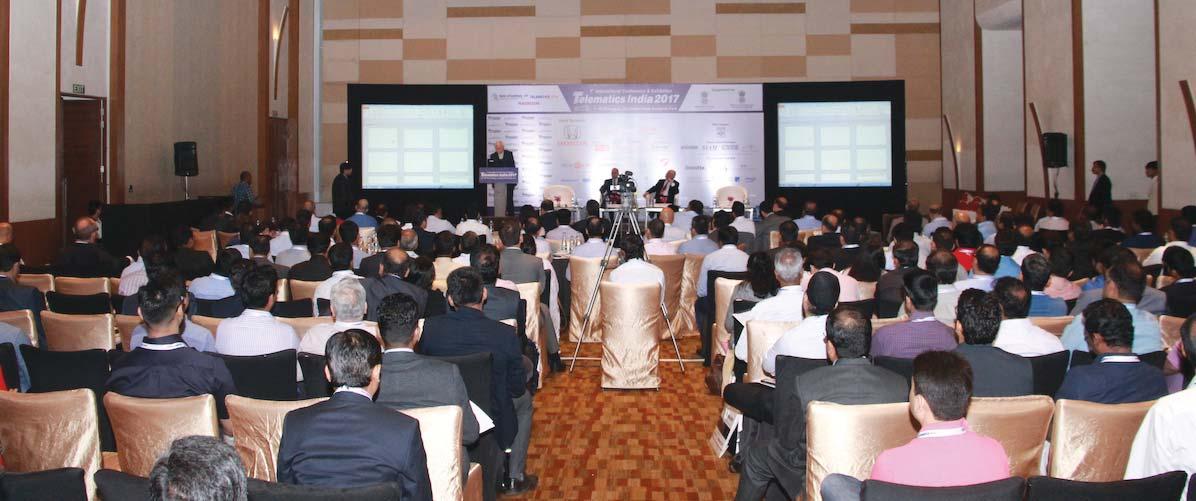
16 minute read
Conference Report & Proceedings TelemaƟ cs India 2017
Conference Report & Proceedings Telematics India 2017
In its seventh ediƟ on, TelemaƟ cs India 2017 covered a wide range of topics in automoƟ ve telemaƟ cs with over 48 speakers and 650+ delegates who joined this conference from over 22 states and 11 countries across the world. Industry CEOs round table lunch meeƟ ng with Shri Ajay Kumar Sawhney, IAS, Secretary MeitY and Shri R Chandrashekhar, President NASSCOM, achieved a substanƟ al progress in aligning government vision and industry perspecƟ ves on transformaƟ ve technologies in mobility and transportaƟ on space.
Advertisement
Welcoming the parƟ cipants to TelemaƟ cs India 2017 on behalf of CoE-IoT and TelemaƟ cs Wire Sanjiv Malhotra, CEO, CoEIoT menƟ oned that the unlikely sectors benefi ted greatly from the advancements in technology. He said CoE IoT is to promote innovaƟ on and startups and emphasized that collaboraƟ ve way was the way forward.
Shri Ajay Prakash Sawhney, IAS, Secretary, MeitY, Chief Guest, opened his address by menƟ oning how the enƟ re area of telemaƟ cs and IoT is dear to his heart. He compared IoT to a bridge that is helping the virtual world to leap out and come into the physical world, which makes physical world to also grow at the exponenƟ al rates characterisƟ c to digital world. Shri Prakash concluded his address with a message that it is important that the larger eff orts be made and we should not stop at small incremental experiments. He urged the parƟ cipants to make it big and help the country go big in this direcƟ on.
MeitY in his inaugural address complimented the audience and expressed saƟ sfacƟ on that the percepƟ on towards technology is changing and is not seen as a threat. He briefed on opportuniƟ es being created by the government and exhorted industry to come forward and at the same Ɵ me cauƟ oned that the power of the IoT could be misused by people with nefarious designs. SoluƟ ons to make systems more cyber secure, test infrastructure and private sector capabiliƟ es will be signifi cant for future.
Shri R Chandrasekhar, President NASSCOM talked about the future of the IT industry. InformaƟ on technology along with communicaƟ on technology has permeated almost every sector; and automoƟ ve sector is the best example. What we see in form of driverless cars only symbolizes the change that is beginning. Lines amongst the technologies and domains are geƫ ng blurred. We no longer see automoƟ ve company and Technology companies as two diff erent enƟ Ɵ es, he brought out there and many other trends in his address.
Nick Gill, Chairman-Global AutomoƟ ve Sector, Capgemini talked about two themes; can money be generated from telemaƟ cs; and how to make money. He said unlike earlier, when industry was pushing telemaƟ cs, we now see the customers are pulling it. CiƟ ng connected services he observed that Indian customers are very interested in sharing their data for geƫ ng
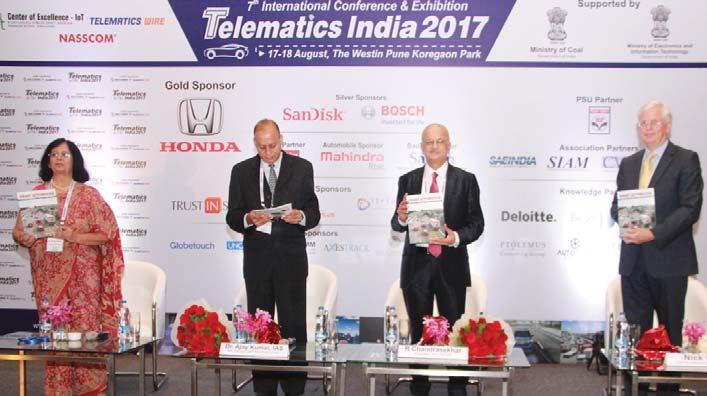
connecƟ vity services, but unwilling to pay for it. Cybersecurity also remains a high infl uence on the customers while going for connecƟ vity services poinƟ ng out that 33% of the customers see mobility services as alternaƟ ve to owning a car while 63% see it as being complementary to buying a car. Coming to his second theme he said that automoƟ ve sector needs to accept that the connecƟ vity has more fi nancial benefi t though presently use cases were less technology based and more of innovaƟ ve business applicaƟ on based and gave examples of apps based use cases.
A Srinivas, Senior Vice President & Head - Product Development, Mahindra & Mahindra said that there is rapid development of technology. Bandwidth and aff ordability have increased, at the same Ɵ me the cost of connecƟ vity has come down drasƟ cally. There is an evoluƟ on of a new kind of lifestyle-a smart lifestyle along with rising stress, increased Ɵ me on road leading to faƟ gue. These circumstances have given rise to a need of specifi c kind of products which can be developed by the convergence taking place between automoƟ ve and telecommunicaƟ on Industry and menƟ oned some of Mahindra’s products providing blend of in car services ranging from Remote Dashboard to LocaƟ on & whether Services.
Markus Pfeff erer, Managing Director-Asia Pacifi c, Ducker Worldwide talked about connected car which has a pivotal role in transforming mobility. There has been growing convergence among automoƟ ve, telecom and IT industries. The connected car will open new moneƟ saƟ on opportuniƟ es like locaƟ on-based adverƟ sing, in car payments, usage based insurance, in car infotainment, car sharing etc. India has very less penetraƟ on in connected cars, only 2% connected vehicles in passenger cars and 1% in commercial vehicles have any kind of connecƟ vity. India also faces challenges like absence of connected car ready infrastructure.
Dr. Neena Pahuja, DG, ERNET India, Department of Electronics & IT (Deity) in her leadership address talked about diff erent opinions regarding autonomous cars arrival but termed it as inevitable. She said that some work is going on LiFi and we may see a form of vehicle to vehicle communicaƟ on via LiFi. Autonomous technology can be hugely benefi cial for disabled so steps must be taken in this direcƟ on. Regarding surface transport, if not totally driverless we can have systems that would be able to avoid accidents. IoT can even be applied in airlines or railwaysnto induce some kind of proacƟ ve control to avoid accidents
Randeep Singh Khokar, Head Electrical & Electronics, Tata Motors said connected cars
Industry round table meeƟ ng with Shri Ajay Prakash Sawhney, IAS and Shri R Chandrashekhar
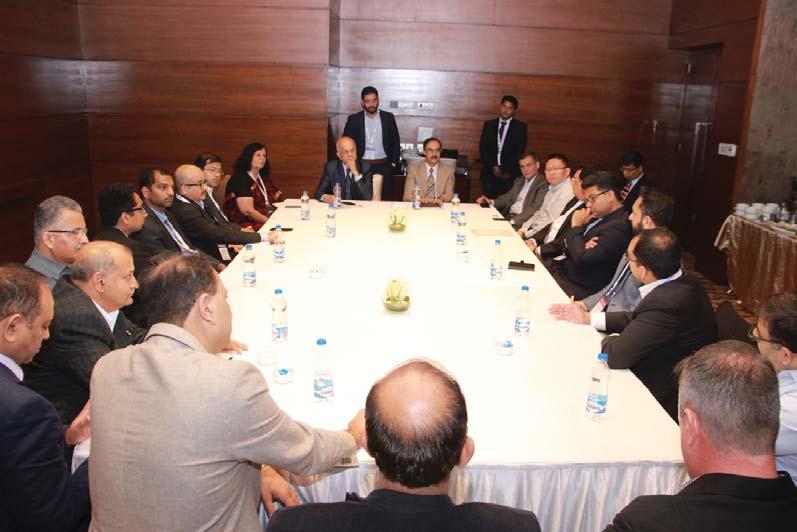
are here and everything we know is going digital and we need to adapt to that yet the fact remains that connecƟ vity is yet another challenge that needs to be addressed.
He said the next challenge is about addressing cyber threats and cyber security must be ensured at three levels. Device security – at the device level, which is at TCU/OBD dongle etc, ConnecƟ on security at Mobile network level for secured data transfer and Cloud security – to take care of the data that’s stored and also to secure the Algorithms from geƫ ng tampered.
Vivek Tyagi, Director-Business Development & Sales, SanDisk India talked about connected cars which will produce 72 zeƩ abytes of data per year, having a value of USD$450 - $700B. He said every car by 2025 will generate 1TB of data per day. This data would need to be stored. The cars would require removable soluƟ ons for applicaƟ ons such as maps, dash cameras and embedded soluƟ ons for applicaƟ ons such as IVI, digital clusters, telemaƟ cs, autonomous drive systems. His company provides soluƟ ons like iNAND e.MMC and SD cards. He also introduced some of the products of his company. vehicles but also in off road vehicles and machines. He talked about the connected mines and soluƟ ons Bosch off ers in mines, like fl eet management, producƟ on management, dispatch management and maintenance management.
Bharath Bellur, Program Manager Connected Mines, Bosch Limited talked about trends of the vehicles in future- electrifi caƟ on, automaƟ on, connecƟ vity and mulƟ modality. He said by 2020 there will be 7 Billion connected people and 20 billion connected things. ConnecƟ vity is not only coming in general to
Ankit Jain, Vice President - Ola Play, Ola Cabs talked about the ride hailing industry in India which he said is facing constraints in exisƟ ng Infrastructure. The cars are designed for the drivers but Ola is trying to bring the control to the rear seat passengers by reinvenƟ ng the back seat space through Ola Play as in future most of us will be passengers, he said. As the car is being seen as workspace in future, Ola is taking steps in this direcƟ on, including personalized experience and entertainment through Ola Play.
Farhana Haque, Vice President & Business Head - IoT, Vodafone opened her talk by bringing out the blurring of lines between diff erent sectors and menƟ oned that we are now a Gigabit society in India and the way we do things is changing. It is a complex ecosystem where the companies with diff erent backgrounds are partnering in diff erent ways in this fast evolving ecosystem. The role of the telecom
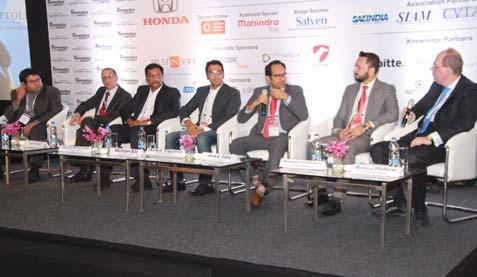
ExhibiƟ on Area
companies will be like the blood and veins for the connected devices. The players in this ecosystem, she opined, will need to understand their respecƟ ve core drivers, develop new innovaƟ ve business models, and leverage the ecosystem.
RiƩ u Koshy, Director - Strategy and OperaƟ ons, DeloiƩ e talked about incepƟ on of tracking and geo-posiƟ oning, which followed the launch of Sputnik some six decades ago. The current market trends in vehicle monitoring are predicƟ ve maintenance; supply chain management and schedule alerts for repair centres. He said that it will transform into things like platooning. Driver and safety which presently include tracking hours of service, monitor safety habits, fuel usage reducƟ on will give way to autonomous vehicles in future. The fl eet management will evolve to fl eet sharing. He also discussed how UPS through the applicaƟ on of telemaƟ cs improved its operaƟ ons.
Jeff ry Jacob, Principal, Roland Berger talked about the trends and opportuniƟ es in TelemaƟ cs industry in India. He said Globally, the vehicle telemaƟ cs market is valued at US$ 39 Billion in 2016 and is dominated by telemaƟ cs for commercial
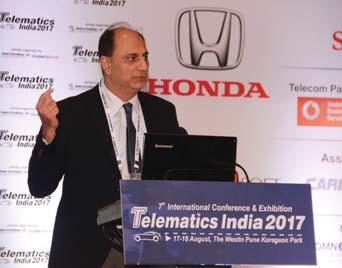
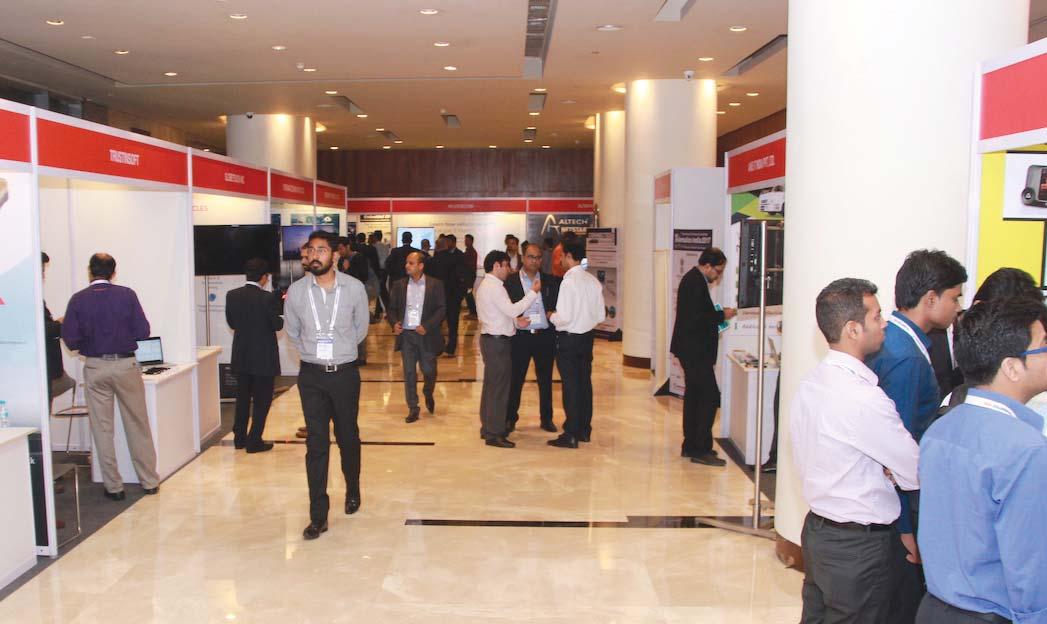
vehicles. It is expected to grow at CAGR 17% to US$ 103 Billion in 2022. In India, he said the commercial vehicle telemaƟ cs market is valued at US$ 113 million in 2016 and expected to grow at CAGR 21% in 2017-22. The changing ecosystem will also lead to new alliances, roles and underlying principles.
Vinod Sood, Managing Director, Hughes SysƟ que. According to him, the buzz around autonomous cars is there but we need to focus on making th e cars more capable and safe. The mass adopƟ on of this technology is challenging and would need government support. ArƟ fi cial Intelligence and Machine Learning should be used for improving road safety. He said that three focus areas A) using data available through OBD device and mobile phones. B) Using dash cams c) Using cameras outside the cars; can help in reducing the accidents. The data collected can be studied along with the help of machine learning and AI to give alerts, warnings etc to drivers and hence prevent the accidents.
Vic Sharma, Head of Business OperaƟ ons (North America), TrustInSoŌ talked about importance of cyber security in connected cars, and informed about TrustInSoŌ Analyzer, which is an advanced staƟ c source code analyzer that performs comprehensive mathemaƟ cal analyses of soŌ ware to fi nd and resolve source code fl aws. He said it can detect all vulnerabiliƟ es and is the only soŌ ware that can mathemaƟ cally guarantee source code quality.
Ravi Jakhodia, CEO, Minda iConnect, sharing the staƟ sƟ cs menƟ oned that India churns out 3.8 million passenger vehicles and 0.8 million commercial vehicles every year. We are more in need for connectedness than the developed world. Indians are also culturally sharing in nature and hence seamless sharing of cars is easier in India. According to him, three big changes to be observed in India are- i) OEMS have turned the focus towards connected services ii) GST will enable faster goods transportaƟ on requiring vehicle tracking Iii) AIS 140 an opportunity to standardise devices in use. He also highlighted possible security threats and remedies in implemenƟ ng connected cars.
Srinath Manda, Associate DirectorAutomoƟ ve & TransportaƟ on, Markets and Markets talked about complex value chain of OEMs, Teir-1s, dealership system, service providers and they all are geƫ ng linked through telemaƟ cs infrastructure. In couple of years telemaƟ cs market will be 45 million from present 10 million. AutomoƟ ve segment is a high opportunity segment but in India the present level of penetraƟ on of telemaƟ cs is very low even lower than countries like Indonesia, he said. We also lack in proper infrastructure and connecƟ vity, he remarked.
Vignesh Sridharan, CPO, Axestrack, Vignesh talked about how in India we have vehicle telemaƟ cs markets which is being driven by the OEMs. Every segment needs data for its own purpose. He concluded by sayingPre-fi t LocaƟ on modules in vehicles is the way forward, dual focus is essenƟ al to drive adopƟ on – owner and user; Flexible Plaƞ orm to cater to varying business cases of End Users.
G Chiranjeevi, Chief General Manager (O&D), Hindustan Petroleum giving a user segment perspecƟ ve menƟ oned that his company has been using vehicle tracking systems since a long Ɵ me. He menƟ oned advantages of using system like Dispatch Planning; Monitoring Driver Behaviour; Real Ɵ me Tracking; TransportaƟ on cost opƟ mizaƟ on; Transporter Discipline.
Panel Discussion on Connected Vehicles & Future Mobility was Moderated by Markus Pfeff erer, Managing Director-Asia Pacifi c, Ducker Worldwide. Panelist in the discussion included Mandeepsingh Khangura, Director, Pointer India; Ankit Jain, Vice President - Ola Play, Ola Cabs; Ankit Taparia, AVP Sales, Globetouch; Mohan BV, Chief Expert of TelemaƟ cs, Robert Bosch; Ranjit Abhyankar, Senior Technical Manager, Delphi India; Kapil Chawla, Industry Leader - Digital TransformaƟ on, Cisco Systems. Some of the key points which were brought up during the discussion included aff ordable services, MoneƟ saƟ on in new business models, 5G connecƟ vity road map, policy decisions to deal with issues like privacy, data security etc. It became evident in discussion that smart infrastructure, disrupƟ ve business models, retrofi Ʃ ed connecƟ vity soluƟ ons will play a very important role. Companies are making cultural shiŌ s, roles are geƫ ng
Panel Discussion: ADAS & Autonomous Vehicles Moderator: Roland Haas, Founder & CEO, QSO Technologies; Pankaj Rabha, Plaƞ orm SoluƟ ons Architect, Advanced Car Labs, Intel CorporaƟ on; Mohan Desu, Vice President – Design & Mechatronics, SatyamVenture; Mitali Mishra, CTO, EC. MOBILITY.
Key points which were brought up during the discussion are: (1) Lines are blurring between domains, we are witnessing rise of mechatronics, (2) Paradigm shiŌ s, cultural shiŌ s are being observed and new business models propping up, (3) OEMs are working with startups, represents the cultural change, (4) Human drivers will be a challenge for the autonomous car in early stages, Level 2, level 3 automaƟ on looks more possible, (5) Autonomous cars will change everything, even for monitoring we would not need police but an autonomous car with cameras, (6) A raƟ ng system can be introduced in the car that can help in introducing automated driving and their regulaƟ on too, (7) Advanced technology is resulƟ ng in deskilling or upskilling-there was no unanimous opinion, (8) The panelists also could not come on one point whether connecƟ vity and automated driving co exisƟ ng or can exist independently too.
Panel Discussion: Commercial Fleet TelemaƟ cs Moderator: RiƩ u Koshy, Director - Strategy and OperaƟ ons, DeloiƩ e; Manish Kumar, Senior Vice President (HoD-IT), DIMTS; Kiran A. R., Technical Director, iTriangle; Sudhir G, CEO, GoodsMover.
Key points which were brought up during the discussion are: (1) Certain impetus from the government like GST seems to be working as there is a need for track and trace as trucks will be covering longer distances, (2) Some changes taking place in India that took a long Ɵ me even in developed countries. RegulaƟ ons from the government are required to be introduced in this sector to things get standardized, (3) UrbanizaƟ on has created the need for new routes, therefore
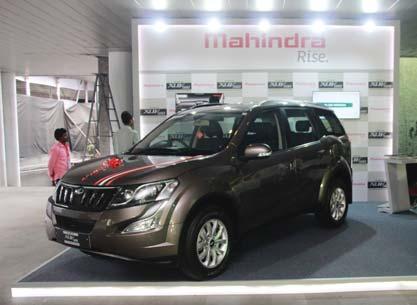
route opƟ mizaƟ on and thus requiring a lot of data, (4) In future we are looking at integraƟ on of diff erent modes of transport, (5) Driver no longer seen as deterrent, now driver relay systems have started being used. Trucks with cabins, comfort to driver is being thought of & (6) The industry is geƫ ng mature, there is more awareness and people are demanding more such kind of services.
Panel Discussion: Connected Services to Connected World Moderator: Maneesh Prasad, Editor & CEO, TelemaƟ cs Wire.
Randeep Singh Khokar giving leadership address
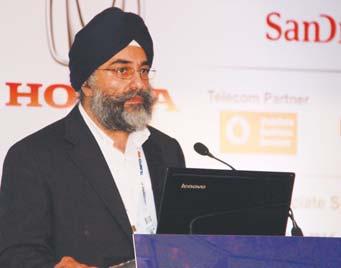
Panelists: Vishwa Kiran, CEO, CarbookPlus; Gary José Chandy, Business Head (OEConnected Vehicles), Minda iConnect; Subramanian Thiagarajan, Senior Manager, Renault Nissan; Vaibhav Kumar Singh, Business Consultant, Volvo.
Key points which were brought up during the discussion are: (1) Challenges and opportuniƟ es both are there in plenty in connected vehicle market in India, (2) Best pracƟ ces from Europe which have been successful there can be brought to Indian markets, (3) Value proposiƟ on of data is diff erent for diff erent OEM, Teir1, Service provider etc., (4) Data security must be ensured and analyƟ cs must be applied according to the user of the data, (5) The focus needs to be on how the services can be uƟ lized by the customer so he/she will be willing to pay for it. The services should be quanƟ fi ed, so the customer can see the monetary benefi t, (6) Vehicle tracking, geo fencing, vehicle health monitoring are some of the basic features which are being introduced in cars in India.
Panel Discussion: TelemaƟ cs SoluƟ ons – Moving Up the Value Chain, Srinath Manda, Associate DirectorAutomoƟ ve & TransportaƟ on, MarketsandMarkets as moderator of the session. Panelists in the session included Olumide Solarin, CEO, Best School of Motoring (Nigeria), Sharmila H. Amin, Managing Director -South Asia India, Bertling LogisƟ cs, Mohit
Vivek Tyagi, Scandisk India giving leadership address
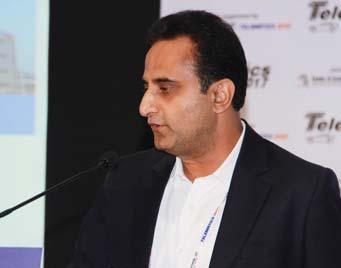
Mehrotra, Managing Director, Omnicomm India, Anand Xavier, Product Management, Global Vehicle SoluƟ ons, UBER. Raghav Himatsingka, Founder, Truckola.
Key points which were brought up during the discussion include (1) Clients’ readiness to invest in telemaƟ cs, as they can now see the posiƟ ve role it plays in increasing the effi ciency, (2) The telemaƟ cs needs to move up from basic track and trace to higher technology applicaƟ ons; only then the penetraƟ on is going to increase, (3) One of the impediments for mass adopƟ on of telemaƟ cs is low awareness and lack of educaƟ on of truck owners to understand the benefi t of telemaƟ cs insurance models over tradiƟ onal insurance.
Small number of truck owners do not have profi t enough to invest in telemaƟ cs. IncenƟ vizing beƩ er driving behaviors can help in improving driving. The owner driver model is reversing as per the trends and both owner and driver stand to benefi t from the cumulaƟ ve socio economic and operaƟ onal benefi ts accruing through telemaƟ cs technologies.
Panel Discussion: Insurance TelemaƟ cs (Hurdles, Lessons, Future) was moderated by Sagar Apte, Founder, CarIQ. Panelist included Vijay Kumar, Principal Offi cer, GoDigit Insurance Puneet Sahni, AVP - Product Development, SBI General Insurance, JaƟ nder Singh, AVP UW, Kotak Mahindra General Insurance Shaun Brashaw, ExecuƟ ve Technology, Altech Netstar.
Key points brought out during the discussion include the facts such as, TelemaƟ cs enables insurance companies to off er benefi ts to the disciplined drivers, lack of regulaƟ ons, diffi culƟ es in operaƟ onal and revenue side. Insurance telemaƟ cs business potenƟ al is esƟ mated at 6-7 k Crore with TelemaƟ cs going to be the key diff erenƟ ator in terms of service and product, few years down the line but exisƟ ng low cost of insurance in India poses a challenge to accommodate the cost of the device. Data security is an issue and will remain a major challenge besides the fact that RoI for consumers becomes visible only aŌ er 2-3 years.









